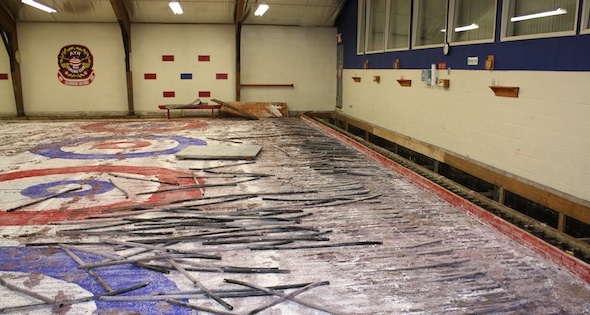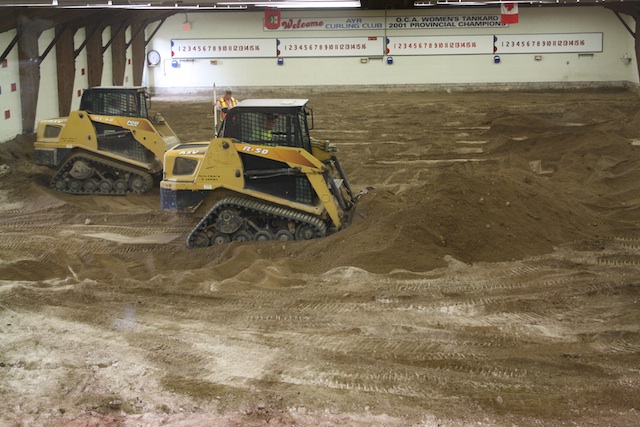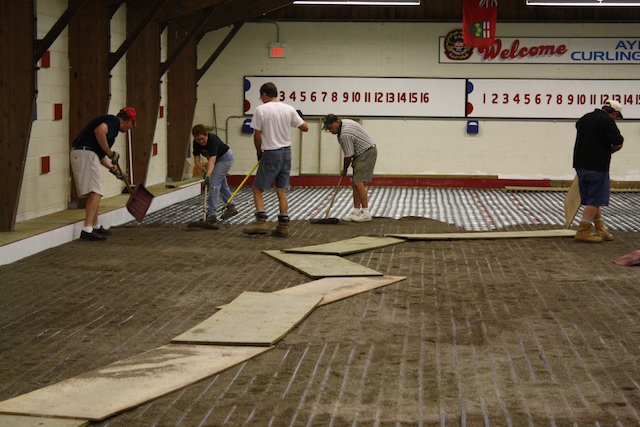Around the House: Renovations have long-term benefits at the Ayr Curling Club
When Ontario’s Ayr Curling Club recognized that energy consumption generated the most costs to the facility, the club’s Board of Directors decided it was time to take action. With the aid of an Ontario Trillium Foundation grant – and the efforts of many club members who volunteered their time and energy – Ayr CC set about making significant improvements that will have long-term benefits to its members.
They’ve been curling in Ayr, in one form or another, since 1850. Nineteenth-century Ayr curlers played on the frozen ponds scattered around the area, eventually moving indoors to a rink in a barn, and finally finding a home in the current curling facility, which opened in 1967 on Robbie Burns Day.
Today, Ayr Curling Club offers league play Sunday through to Friday, with Saturday reserved for a full roster of bonspiels throughout the season.
And like any small club, it’s a balancing act to keep up with the costs of operation and continue to bring curling to the community – even more difficult when the Board of Directors learned that their facility’s energy consumption and costs were rising.
“A study was done in 2010 to track energy consumption and costs for the facility over the previous 5 years and it was discovered that electricity use was the greatest component of our energy costs,” says Ayr’s Richard Totten. With Ontario’s hydroelectric power rates expected to increase by 50 percent over the next five years, the Board decided it was time to take action.
First, the Board determined that lighting and refrigeration were the biggest energy draws. With that knowledge, they tackled the problem of how to make the necessary renovations and, most importantly, how to fund the project.
Enter the Ontario Trillium Foundation program. The neighbouring Galt Curling Club had recently completed an application for a Trillium grant, assisted by members of the Ayr club, so a possible solution to the funding dilemma was easy. A Trillium Project Team was organized, chaired by Totten, and the process began.
Preparing a formal application, like the one required by the Ontario Trillium Foundation, can be a daunting task for an organization like a small curling club, made up of community members, all volunteers.
“Writing the proposal was not as difficult as one may think,” says Totten, explaining that the document includes three basic parts: the project’s scope, costs, and funding solution. “Project scope needs to be identified and agreed upon by your club’s Board of Directors. It is advisable, if the type of work has been performed by other clubs, to get in contact with those clubs to find out how they proposed and executed their projects. We also contacted our OCA representative to discuss what we planned to do and obtained information to support our proposal.”
The responsibility for obtaining quotes for goods and services was divided up among committee members, and a comparison spreadsheet allowed the committee to come up with an estimate of costs and, finally suggestions for funding the project. Funding might include the expected grant, but that won’t cover the entire cost, so the proposal also had to indicate club fundraising plans and other options.
The biggest challenge was actually submitting the proposal online, says Totten, who describes the process as “an adventure in itself.”
But it all paid off in a $74,900 Ontario Trillium Foundation grant – and a new floor in the ice house incorporating insulation and piping to help reduce energy consumption and save the club money.
The grant proposal has produced other benefits as well, according to Totten.
“It has made us a better club,” he says. “Volunteers who worked the project can experience the fruits of their labour and others, who could not give their time due to other responsibilities, have let it be known to these volunteers that they have done a great job.”
Some final advice from the Trillium Project team at Ayr?
“This is not a one-person project,” advises Totten. “Pull together a team of persons with the knowledge and skill sets to make this project successful. Work as a team. All the final solutions should not come from your chairperson but from each individual on that team. Lines of communication must be set up between your Board, the committee and the volunteers to assure the project is executed in a cost effective and timely manner. Work with your volunteers for you may find some hidden gems that will come to the plate and hit a home run for you.”







